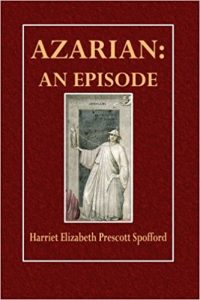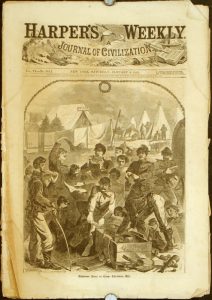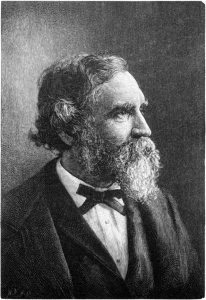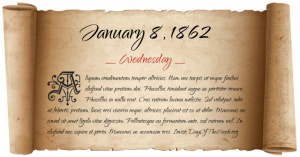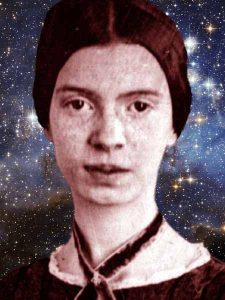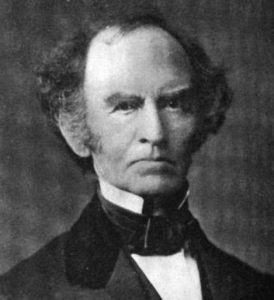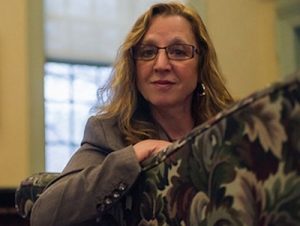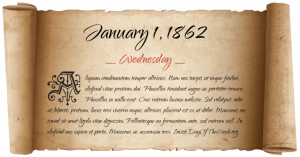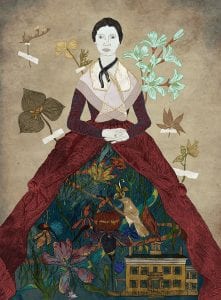
The Third “Master Document”
Many poems Dickinson wrote during this year address what we might call “mastery”: mastery of her craft of poetry, of her time and space, as well as mastery by overwhelming feelings of love, loss, grief, power, powerlessness. Poems often involve issues of scale: the tiny and the huge, the daisy and the mountain, degrees and titles, royalty and subjects. Where there is a Master, though, there is inevitably a slave—language that suggests the political and ethical tensions underlying the Civil War.
We take up these themes in an exploration this week of the Third “Master Document,” previously known as the "Master Letter." After Dickinson’s death, three documents were found in her papers that scholars dubbed the “Master Letters.” They are grouped together because they all address an unnamed “Master,” appear to be drafts, but were never sent to a correspondent. According to R. W. Franklin, who published an edition of the three letters in 1986, they “stand near the heart of her mystery.” (Read his introduction). After studying the evolution of Dickinson’s handwriting, Franklin reconsidered previous scholars’ ordering and dating of the letters. He dates the first one, beginning “Dear Master / I am ill,” to Spring 1858. The second one, beginning “Oh – did I offend it –,” to early 1861, and the third and longest, beginning “Master / If you saw a bullet,” to summer 1861. The third document in this group has so much resonance for poems composed in 1862, we could not resist highlighting it.
In 2021, Marta Werner published an updated and expanded edition of what she calls “Dickinson's Master Hours.” In her “Historical Introduction” she aims to “unsettle” the identity of the “documents” as letters and recast them as “an early writing experiment (ca, 1858-ca.1864) … a master constellation … a cartograph or a ‘deep map’” that precedes and shapes Dickinson's experiment with the fascicles. She slightly revises Franklin's dating and adds two poems to this constellation, “Mute — thy Coronation” (F133, J151) and “A wife — at Daybreak” (F185, J461), also providing helpful timelines of events for each of the documents. An appendix examines other “Master” poems from the fascicles and offers candidates for inclusion in this category, some of which we consider in our section on Poems.
Richard Sewall, a Dickinson biographer, pronounces dramatically about the Third “Document”:
Like many a scene in one of Shakespeare’s more tightly knit tragedies, this letter may be regarded as a microcosm of the whole. Emily Dickinson’s whole life is here, the history of what could be called its failures and the reason for them and the prevision of its triumphant success and the reason for that.
For years readers have puzzled over the identity of the “Master,” and come up with different answers. (For a helpful summary, see Marianne Noble’s entry on “Master” in An Emily Dickinson Encyclopedia.) In his desire for readers to experience the materiality of these letters, Franklin includes printed facsimiles stowed in a large envelope, so that we, their contemporary readers, have the dizzying experience of opening them up as if we were their recipients!
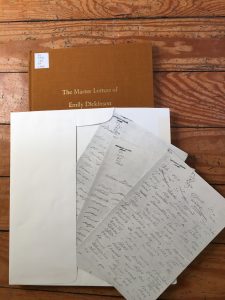 The passionate and seemingly uncensored language of these texts leads many to read them as missives from a woman scorned. In the second text, for example, Dickinson describes herself, in the third person, as virtually slayed by her feelings:
The passionate and seemingly uncensored language of these texts leads many to read them as missives from a woman scorned. In the second text, for example, Dickinson describes herself, in the third person, as virtually slayed by her feelings:
A love so big it scares her, rushing among her small heart — pushing aside her blood — and leaving her all faint and white […] I’ve got a cough as big as a thimble — but I don’t care for that — I’ve got a Tomahawk in my side but that don’t hurt me much, Her Master stabs her more.
Rather than reinforce the obsession with Dickinson’s love life, however, we focus on the writing in these extraordinary documents. For this discussion, we are indebted to the work of Renée Bergland, who has kindly shared ideas from her book in progress, provisionally titled Planetary Poetics: Emily Dickinson and Literary Relativity.
Bergland offers Adrienne Rich’s brilliant 1976 essay about Dickinson and power, “Vesuvius at Home,” as a framework. Rich rejects Thomas Wentworth Higginson’s evaluation of Dickinson as “partially cracked,” and the 20th century myth of a “fey or pathological” spinster, and imagines her “as a practical woman, exercising her gift as she had to, making choices. … too strong for her environment, a figure of powerful will …” Rich insists:
It was a life deliberately organized on her terms. The terms she had been handed by society—Calvinist Protestantism, Romanticism, the 19th-century corseting of women’s bodies, choices, and sexuality—could spell insanity to a woman genius. What this one had to do was retranslate her own unorthodox, subversive, sometimes volcanic propensities into a dialect called metaphor: her native language.
In this vein, Bergland considers Dickinson’s use and revision of “master narratives” in the Third Master document. For example, how these texts defy genre, logic or, rather, phallologic (the language and law of the Fathers, the phallus), and the physics of scale. Are they letters if they were never sent? The second text does not even have a salutation. Are they poems (some parts of them scan) or prose poems or essays? Or a repository or catalogue of ideas, figures, and images for poetry? Or some kind of hyperobject? Tim Morton, author of The Ecological Thought (2010), defines a hyperobject as an object bursting with vitality, overruling distance, “molten” and “nonlocal”– that is, challenging the fixity of spacetime – and “interobjective,” or formed by relations between many objects.
Look at the image and read the transcript of the Third “Master Document” and you will see why this last description might be the most appropriate for it. Dickinson at her rhetorically volcanic best.
“Curious Intelligence in a Slave”
NATIONAL NEWS
This week, people all over the United States watched the events of the Civil War play out slowly. Since its inception the year before, only small skirmishes had occurred, no major battles. During the week of January 15-21, 1862, one of these skirmishes resulted in a Union victory: the Battle of Mill Springs. This battle took place on January 19 and marked the progress of the Union army into Kentucky, representing a slow but steady acceleration of the overall war. This first major Union victory eventually led Confederate Major General George Bibb Crittenden to resign in the fall of 1862. It was celebrated in the press and covered in both the Springfield Republican and Hampshire Gazette.

Also noteworthy was the resignation of Simon Cameron, President Lincoln’s Secretary of War, on January 15, to become the minister to Russia. Although historians determined that he was corrupt and incompetent, and annoyed the president by calling for the emancipation and arming of freed slaves way before Lincoln was ready to make this declaration, Cameron’s stated reason for leaving his position was that he did not find the work pleasant or enjoyable. The lack of major victories on either side led to a sense of restlessness and loss of faith in the war effort. On January 18, the Springfield Republican wrote that the present generation has
given up a belief in the future reign of peace, and if not also of good will among men, at least of other arbitraments than that of war for the solution of national differences.
LOCAL NEWS
The war was a large part of regional culture as well. On January 18, the Springfield Republican reported on the plan of Edmund Dwight, a wealthy businessman whose family members were leaders in education, to set up a military academy to educate and train soldiers. This would insure the army would be comprised of volunteers, rather than conscripts. The effects of the war were amply felt in Amherst. On January 14, the Hampshire Gazette described the solemn atmosphere at Amherst College:
one can but mark the effect which the call of their agonized country has wrought upon a company of generous, warm-hearted, young men.
Each edition of the Springfield Republican published updates on astronomy and science. On January 18, the paper discussed a new consensus among scientists that
throughout the whole universe there is diffused an ethereal medium which chemists cannot touch, and that the heat which we feel is communicated by motions of this body.
Another feature to note is the Republican’s publication, in a section called“Original Poetry,” of two poems by Caroline A. Howard, who we have not been able to identify further. The first, “By the Shore,” echoes the situation, if not the eroticism and fantasy, of Dickinson’s “I started Early – Took my / dog,” which we featured last week:
With the lighter burdens of life opprest
So weary in heart and mind,
With the ceaseless longings that fill my breast
With pain that is undefined,
I come with a tremulous hope of rest,
At last to thee,
O whispering sea!
The Hampshire Gazette for this week published an anonymous poem called “The Armies,” which emphasized the need for the war to progress and “march forward.” This was a popular point of view at the time.
Finally, in a section of the Republican called “Selected Miscellany,” a short article appeared titled, “Curious Intelligence in a Slave,” culled from the Free Press, Burlington, VT. The author, who lived on a cotton plantation for several years, told about an older enslaved man he met called Allan, whose job it was to weigh the baskets of cotton picked by the slaves and report the amounts every evening.
And though I subjected Allan to the severest tests I could think of to be assured of his accuracy, I never found a single occasion to doubt it.
“Master and Daisy”
According to Jay Leyda, Dickinson wrote only one letter this week, to Samuel Bowles’s wife Mary, who was in New York. She sent a rose and asked that they put it in the “small hands” of their infant son Charlie at night so he will dream of “Emily,” and when they meet, they will be “old friends.” Dickinson worried that Charlie will cause her friends to forget her and, in a barely concealed threat, says:
We shall wish he was’nt there– if you do– (L 253).

Dickinson’s passionate sense of attachment–to the point of violence–is fully on display in the Third Master Document. Many readers focus on the differences in scale Dickinson employs there: she addresses a distant figure she calls “Master” and refers to herself as “Daisy,” and in that diminutive guise seems to abase herself to the larger, often overpowering force.
This same term appears in several poems she wrote in the later 1850s and early 1860s. In his extensive exploration of the popular concept of "romance" that shaped Dickinson's "private mythology," Barton Levi St. Armand notes that "in the Victorian language of flowers the daisy was an emblem of innocence." Other critics argue that behind this usage is the myth of Apollo (or Helios/Sol) and Clytie, in which Clytie transforms into a daisy or sunflower as evidence of her devotion to the male force.

To support this reading, Sylvia Henneberg points to three early poems: “Glowing is her Bonnet” (F106B, J 72), “‘They have not chosen me’ –he said” (F87A, J85), and “The Daisy follows soft the Sun” (F161A, J 106). But she also observes that “daisy” derives from the Old English “day’s eye,” and in this sense, “represents a force with which the male – the sun – must contend,” a force of independence and strength. In a poem dated to 1859, Dickinson herself takes a playful attitude to the trope:
In lands I never saw – they say
Immortal Alps look down -
Whose Bonnets touch the firmament -
Whose sandals touch the town;Meek at whose everlasting feet
A myriad Daisy play -
Which, Sir, are you, and which am I -
Opon an August day? (F108A, J 124)
Reflection
Renée Bergland
 August, 2015. My colleague is scarlet. He’s forty-five years old and I have always thought of him as worldly. I have never seen him blush like this. He laughs and almost stammers when he tells me that he made a very embarrassing mistake this morning, reading my book manuscript. The last part of the draft is a shaggy pile of conference papers and notes, with wild swerves in tone, but I don’t think it is terrible. Why is he so flustered?
August, 2015. My colleague is scarlet. He’s forty-five years old and I have always thought of him as worldly. I have never seen him blush like this. He laughs and almost stammers when he tells me that he made a very embarrassing mistake this morning, reading my book manuscript. The last part of the draft is a shaggy pile of conference papers and notes, with wild swerves in tone, but I don’t think it is terrible. Why is he so flustered?
It comes out. He has never read Dickinson’s third Master document. Finding it in the middle of the pile, he’d mistaken it for a private musing written by me. He’d thought I was on drugs when I wrote it, maybe, or delusional. He’d been shocked by my passion, my startling (and uncharacteristic) lack of prudery. Eventually, he tells me, he’d recovered enough to continue reading, and picked up on the context clues in the following discussion enough to figure out that Emily Dickinson wrote that thing. In 1861. Even so, he has trouble looking me in the face all afternoon. I have shocked my colleague to the core.

My own first encounter with this text was less disorienting: my friend Marianne Noble presented me with a clearly marked copy when she was working on an essay about Dickinson’s eroticism. Because I read the document before I knew much about Dickinson, my experience of reading Dickinson’s poetry is forever shaped by the experience of reading the text beforehand. I expect Dickinson’s work to be shameless. But my colleague’s startled reaction makes me understand what a surprising document it is. I would blush too, if I found a text like this in a friend’s files. It’s intimate, too intimate. It is artful—beautiful even—but it’s not polite. No filters, no rules, no protections. It’s naked. It’s dazzling.
In My Emily Dickinson, Susan Howe remarks that
Attention should be paid to Dickinson’s brilliant masking and unveiling (27).
As if we had any choice. No reader can look away, though none can really quite understand what they are reading either.
Poems and poets of the first rank remain mysterious,
Susan Howe explains (27). The third Master document breaks every rule of grammar and logic and narrative, upends all proprieties, immerses us in its passionate tide of exalted emotion, and takes us outside of language and every other system. Although they are addressed to a master, the words transform mastery into mystery. These words are shameless, honest, and dazzlingly mysterious: It’s enough to make any reader blush.
Bio: Renee Bergland is Hazel Dick Leonard Professor of English, Simmons College and Visiting Professor of English and Women's and Gender Studies, Dartmouth. She says:
Like every cultural critic worth her salt, I am curious about everything. My research and writing tend to focus on nineteenth-century America, but in every piece I push against national and historical boundaries, trying to find (or make) connections and to think outside of disciplinary boxes. My first three monographs may seem to be on wildly different subjects: Native Americans, Women in Science, and Emily Dickinson. But there is a methodology to my madness. All of my work tends to span broad expanses of time, to offer slightly startling juxtapositions, to rely on close readings of both literary and historical texts, and to explicitly advocate a dialogic ethics of analysis. I keep trying to connect the past to the present.
Sources
Dickinson, Emily. The Master Letters of Emily Dickinson. Ed. R. W. Franklin. Amherst: Amherst College Press, 1986.
Werner, Marta. Writing in Time: Emily Dickinson’s Master Hours. Amherst: Amherst College Press, 2021. (available online from Fulcrum as an ebook)
Hampshire Gazette, 14 Jan. 1862.
Howe, Susan. My Emily Dickinson. New York: New Directions, 2007.
Leyda, Jay. The Years and Hours of Emily Dickinson. vol. 2. New Haven: Yale University Press, 1960, 45.
Rich, Adrienne. “Vesuvius at Home.” Parnassus: Poetry in Review. 5 (1, 1976).
St. Armand, Barton Levi. Emily Dickinson and Her Culture: The Soul’s Society. Cambridge: Cambridge University Press, 1984, 81.
Springfield Republican, 18 Jan. 1862.
–



